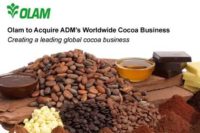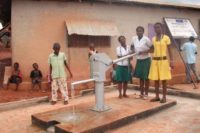Olam Cocoa has achieved 100 percent traceability of directly sourced cocoa across its global supply chain — a commitment the company first made five years ago.
This means Olam can now track approximately 12 percent of the world’s cocoa beans back to an individual farm or community.
“Cocoa traceability has been a significant challenge for the industry due to the fragmented farming systems and lack of infrastructure in many cocoa growing areas,” said Gerard A. Manley, CEO, Olam Cocoa. “To deliver on our commitments we require an unprecedented level of granular data and on-the-ground expertise to effectively monitor our supply chain and act on issues such as child labor and deforestation.”
This breakthrough is the first significant milestone for Cocoa Compass, Olam Cocoa’s sustainability ambition for the future of cocoa.
In a progress update published Sept. 21, 2020, the company confirmed it is on track to meet other targets as well, including a commitment to achieving 100 percent deforestation and child labor monitoring across all managed sustainability programs worldwide in its direct supply chain by the end of 2020.
“Reaching our traceability goal is a breakthrough moment, and one that has only been possible due to the expertise of our teams on the ground and a sustained investment in digital innovation,” said Andrew Brooks, Global Head of Sustainability. “The door is now open to making our vision of a professionalized, sustainable cocoa supply chain a reality"
To achieve 100 percent traceability, Olam Cocoa has developed an end-to-end traceability system which tracks the cocoa at every stage in the direct supply chain across nine countries: Brazil, Cameroon, Côte d’Ivoire, Ecuador, Ghana, Indonesia, Nigeria, Papua New Guinea and Uganda.
By collecting data such as farm and community metrics, cocoa bean purchasing and transportation information, and details on the facility where the cocoa was processed, it can provide unprecedented transparency for customers and allow sustainability programs targeted at tackling child labor and deforestation to be tailored to the specific needs of farmers and cocoa-growing communities.
“A combination of our organization infrastructure and the processes we have developed over the past 25 years combined with the rapid increase in mobile and internet capability, means that our field teams can now collect, transmit and analyze reliable and consistent data in even the most remote locations,” Manley said. “This is supported by the latest technology, such as real-time satellite mapping systems that penetrate cloud cover.”
This builds on insights from existing tools, namely the Olam and Farmer Information System (OFIS), which feeds through to Olam’s sustainability insights platform, AtSource.
A dashboard shows where the cocoa beans have come from, as well as the social and environmental impact they have had on their journey from source to manufacturer. More than 325,000 cocoa farmers across Asia, Africa and South America are now using Olam’s sustainability technology to share their data in this way.







